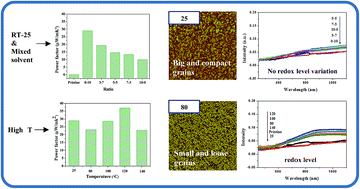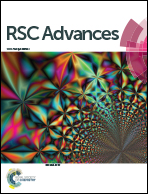The optimization of thermoelectric properties in a PEDOT:PSS thin film through post-treatment†
Abstract
Poly(3,4-ethylenedioxylthiophene):poly(styrene sulfonate) (PEDOT:PSS) has been investigated as a thermoelectric (TE) material extensively. Post-treatment using various solvents has been used to improve its TE performance. Nevertheless, the effects of using mixed co-solvents and post-treatment temperature have hardly been systematically studied. Herein, the TE properties of PEDOT:PSS thin films after solvent post-treatment are investigated. Different ratios of ethylene glycol (EG) and dimethyl sulfoxide (DMSO) as co-solvents and different treatment temperatures are used to optimize the TE properties. It is demonstrated that DMSO post-treatment is more efficient than the co-solvent or EG single solvent at removing insulating PSS from these thin films due to its high dielectric constant. DMSO treated specimens exhibit a power factor as high as 28.95 μW mK−2. Under room temperature post-treatment, PSS is depleted and conformational changes of PEDOT are triggered. This leads to higher electrical conductivity, without an apparent effect on the redox level of PEDOT. Under higher treatment temperature, PEDOT:PSS shows a certain degree of reduced form which leads to a higher Seebeck coefficient. Meanwhile, the electrical conductivity drops and the Seebeck coefficient increases first and then drops with increasing temperature. The reason that the Seebeck coefficient increases is mainly because of the redox level variation under high temperature. With the combination of co-solvent and temperature, the highest power factor of 37.05 μW mK−2 is obtained for PEDOT:PSS post-treated with DMSO at 120 °C. Assuming a thermal conductivity of 0.17 W m K−1, the corresponding ZT of such PEDOT:PSS film is 0.065. This demonstrates that post-treatment is an effective way to optimize the TE properties of PEDOT:PSS. Furthermore, the combined use of solvent and temperature shows the potential of effective tuning of the TE properties of PEDOT:PSS via a more simple and environmentally friendly process.


 Please wait while we load your content...
Please wait while we load your content...